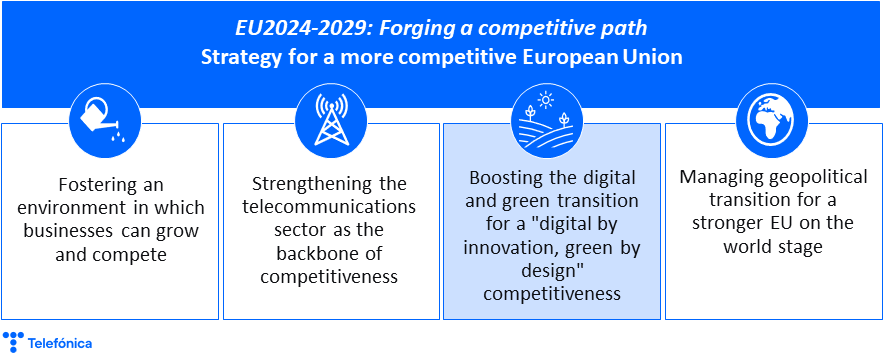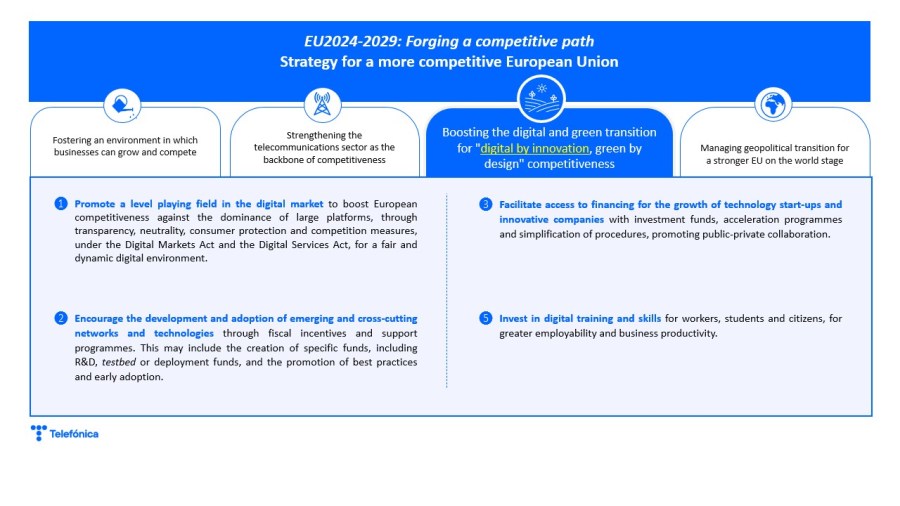In June, we began a series entitled EU 2024-2029: Boosting competitiveness where we analyse Telefónica’s vision on how to strengthen competitiveness and better position the society and economy of the European Union (EU) on the global stage. This series coincides with the start of the institutional cycle that runs from 2024 to 2029 after the European Parliament elections. Undoubtedly, competitiveness will be the central priority guiding the EU’s forthcoming policy and legislative initiatives in this period.
The first post analysed the current state of competitiveness in the EU, the second focused on the first axis of the competitiveness strategy proposed by Telefónica, and the third focused on the second strategic axis, the importance of strengthening the telecommunications sector as a lever for competitiveness in society. In this fourth post, we analyse the third axis, which we have divided into two: Boosting the digital and green transition for “digital by innovation” competitiveness, “green by design”. We then focus on the first part: “digital by innovation”.

Digital competitiveness through innovation
Digital innovation is not just a tool; it is the spark that drives economic growth and competitiveness. From the advent of the internet to the deployment of revolutionary technologies such as artificial intelligence (AI), the Internet of Things (IoT), cloud computing, augmented reality and cybersecurity, digital innovation has driven significant advances in all areas of society. These technologies have become the alphabet with which we will write the future.
Digital innovation has significantly driven global economic progress. The internet has contributed to 21% of GDP growth in developed economies and accounts for 4.5% of global GDP. AI, with an expected impact of $15.7 billion by 2030, and IoT, with a projected annual impact of up to $11.1 billion by 2025, are revolutionizing multiple sectors. Cloud computing, with an estimated market of $364 billion by 2022, and augmented reality (AR) and virtual reality (VR) technologies, with an estimated market of $209.2 billion by 2022, are transforming business operations. Finally, cybersecurity spending, estimated at $133.7 billion by 2022, underscores the importance of protecting the expanding digital economy.
Business impact
Companies, from the most incipient startups to the largest corporations, have in their hands the possibility of transforming their business models thanks to digital innovation. It is about optimising processes, improving products and services, and exploring new markets. The ability to adapt and take advantage of digital innovation is now the decisive factor for competitiveness and the transformation of essential services such as healthcare, justice and education.
Digitalisation not only offers us efficiency; it gives us the opportunity to aspire to great transformation processes and create digital solutions that can manage industry (Industry 4.0), agriculture (agrosmart), cities (smartcities) and the environment (smartgrid) more efficiently. These innovations boost productivity, sustainability, job creation and the quality of services.
Collaborative digital ecosystem
The dynamism of digital innovation is intensified when a policy environment that promotes innovation from conception to adoption converges.
This environment includes quality digital infrastructures, adequate skills and a collaborative ecosystem where companies, public institutions and research centers interact to seize the opportunities of digitalization.
A prerequisite for this is that a level playing field and fair competition are incentivized, laying the foundations for a sustainable and inclusive digital future. Indeed, the Letta report highlights that existing sectoral regulation has introduced significant regulatory asymmetries between telecoms operators and large gatekeepers in many relevant digital markets.
This has created imbalances in the relationships between different actors, challenging the level playing field. In addition, recent digital regulations such as the Artificial Intelligence Act, the Digital Services Act, the Digital Markets Act and the Data Act will require ensuring a level playing field so that all can compete.
Public policies to boost competitiveness “digital by innovation”
For Europe to reach its full potential in digital innovation and competitiveness, we must create a balanced and fair digital ecosystem. An environment that fosters the development of ‘made in Europe’ digital services, tailored to the needs and preferences of European citizens and businesses.
We are at a critical juncture for the European economy, and this sense of urgency compels us to act by developing targeted policies and avoiding the tendency to regulate merely for the sake of regulation. This new European cycle must be recognized as a time for action to build a future where digital innovation finally becomes a hallmark of the European economy. To this end, progress should be made in favour of:
– Ensuring a level playing field in the digital marketplace
– Promoting emerging and cross-cutting technologies
– Facilitating access to finance
– Investing in digital training and capacity building
Ensuring a level playing field in the digital marketplace
It is essential to boost the competitiveness of European companies in the face of the dominance of very-large platforms. This can be achieved through transparency, neutrality, consumer protection and competition measures, international cooperation and continuous monitoring. Digital Markets and Digital Services laws must ensure a fairer and more dynamic digital environment.
Promoting emerging and cross-cutting technologies
Supporting the development and adoption of emerging and cross-cutting technologies is essential. This includes resources for an effective EU standardization strategy, fiscal incentives, and support programs for technologies such as connectivity (fibre and 5G), AI, biotechnology, clean energy, cybersecurity and cloud computing. The creation of dedicated funds for R&D, standardization, testbed, and deployment, as well as the promotion of best practices and early adoption, are key measures for this purpose.
Facilitating access to finance
It is crucial to provide access to finance for the growth of technology start-ups and innovative companies. This can include investment funds, venture capital, accelerator programmes and simplification of administrative procedures for start-ups. Promoting public-private collaboration is also key to support the development of a robust innovation ecosystem.
Investing in digital training and capacity building
Digital education and training are essential for boosting the employability and productivity of companies. Programmes aimed at workers, students and citizens in general can better prepare the workforce for the demands of the digital market. Investing in digital skills will ensure that the technological transition benefits society.
Conclusion
We live in extraordinary times. Technology is advancing rapidly, transforming every aspect of our lives and redefining almost everything. In this context of constant change, competitiveness and sustainable growth are not just goals, but imperatives that require bold and visionary action. This moment calls for an accelerated transition towards a digital and green future, towards more innovative and sustainable production models. A future where innovation is our compass and sustainability our goal.
The challenge of competitiveness and sustainable growth in a context of constant technological evolution requires an accelerated transition towards more digital and innovative production models. Europe must focus on implementing existing regulation by promoting a level playing field, encouraging the adoption of emerging technologies, facilitating access to finance and ensuring adequate digital literacy for all its citizens.
This is the only way to ensure that the value generated by the digital and green transition remains in the EU, benefiting businesses, citizens and society as a whole. The key lies in public-private partnerships and a long-term, strategic vision to position Europe as a leader in digital innovation and sustainability.












